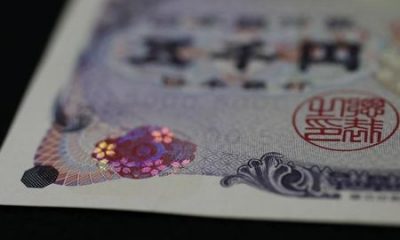Forex
Egyptian pound steadies after devaluation, IMF deal
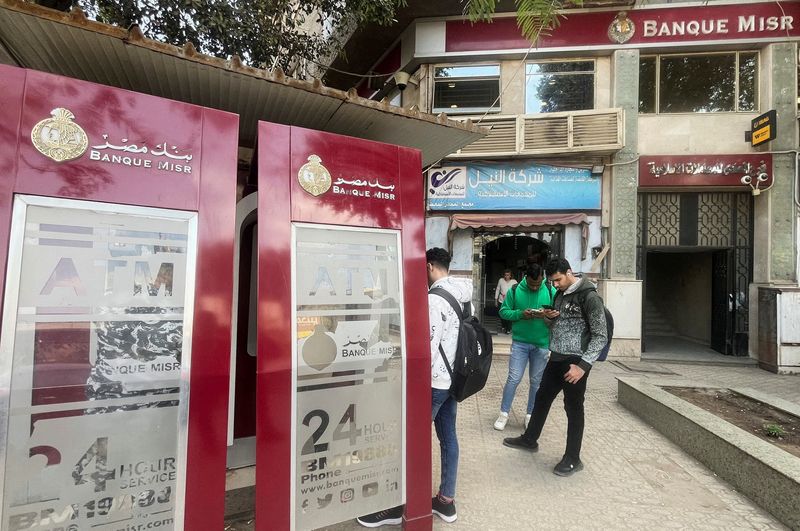
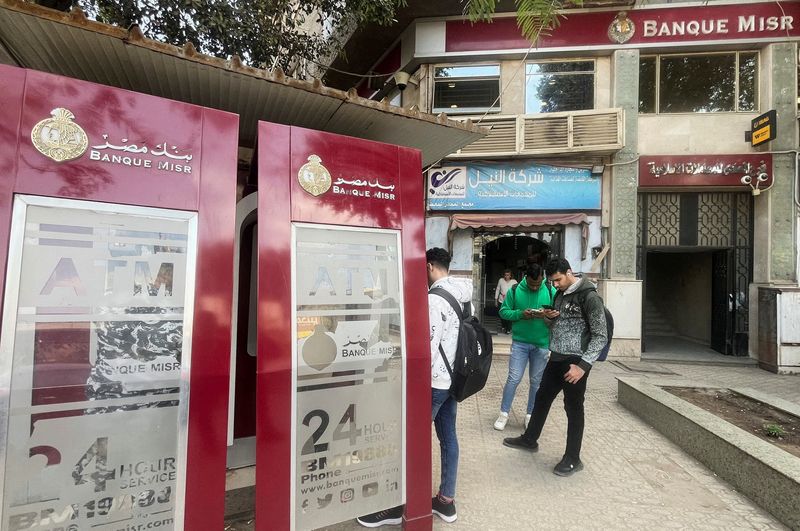
© Reuters. FILE PHOTO: People wait on line to withdraw money from ATM machines at Banque Misr in Cairo, Egypt, March 6, 2024. REUTERS/Amr Abdallah Dalsh/File Photo
By Nafisa Eltahir
CAIRO (Reuters) -Egyptian officials said they expected more inflows and the pound held steady on Thursday, a day after the central bank announced a shift to a more flexible exchange rate and let the currency plunge as Egypt secured an expanded $8 billion IMF programme.
The pound hovered just under 49.5 to the dollar, similar to the price near closing on Wednesday, LSEG data showed. Before Wednesday’s de-facto devaluation, steep interest rate hike, the central bank had held the currency for about a year at just under 31 pounds to the dollar.
A more flexible exchange rate, long a key demand from the International Monetary Fund, is seen as crucial for restoring investor confidence in an economy hobbled for the last two years by a foreign currency shortage.
In one sign of improved sentiment, foreign investors resumed purchases of Egyptian treasury bills after a long absence, three bankers said.
The shortage has curbed local business activity and led to backlogs at ports and delays in the government’s payments for commodities including wheat.
Prime Minister Mostafa Madbouly said Egypt was planning on big deals to ensure liquidity and would work with merchants to stabilise prices and prioritise foreign currency access for basic commodity importers as the currency shift takes effect.
Egypt expected a total of $20 billion from multilateral and other partners including the IMF, the World Bank and the European Union, Finance Minister Mohamed Maait said.
The government was also committed to a programme to sell state assets and encourage private sector investment.
“We are expecting to execute several deals in the various strategic sectors for an amount close to $3.5 billion,” Maait told the American Chamber of Commerce in Cairo. “We are expecting more financing to come through over the short term.”
Egypt’s international bonds, which had soared on Wednesday before falling back, declined further on Thursday, with the 2033 note down 1.62 cents on the dollar at 81.81 cents, Tradeweb data showed.
Overall, Egypt’s sovereign bond prices were trading at early March levels.
‘ENOUGH AND MORE’
Egypt has promised a move to a more flexible exchange rate system in the past, only to resume holding the currency at a fixed rate, while much of the economy depended on a black market rate that fell as low as 70 pounds.
Central bank Governor Hassan Abdalla described the black market trading as a “disease” that reflected a lack of trust in the financial system.
“Thankfully, I can stand here today and say we have enough to fulfil our obligations and more,” he told reporters at a rare press conference late on Wednesday.
The central bank would still have the ability to intervene, as in other countries, in the case of excess volatility, Abdalla said.
The IMF, which agreed to add $5 billion to its existing $3 billion loan programme with Egypt, has said it is looking for a sustainable and unified exchange rate determined by the market.
Under the programme, Egypt has committed to undertake structural reforms to stabilise prices, manage the debt burden and encourage private-sector growth.
Abdalla said that following a 600 basis point hike on Wednesday, Egyptian interest rates, long among the highest globally, would now be on a “downward track.”
‘IRON FIST’
Two weeks ago, Egypt signed an investment deal with Emirati sovereign fund ADQ that includes $24 billion payment for rights to develop a prime stretch of Mediterranean coastline.
It also includes the conversion of $11 billion in existing deposits to be used for unspecified projects across Egypt. The Egyptian government said the total of $35 billion would be transferred within two months.
Since early 2022, when the foreign currency shortage worsened, the pound has now lost more than two-thirds of its value against the dollar in a series of staggered devaluations.
The war in Gaza and attacks on Red Sea shipping have put at risk receipts from tourism and Suez Canal traffic, two other main sources of hard currency. Suez Canal revenues had dropped by more than 50%, Maait said, though Egypt’s tourism minister said visitor numbers rose at the start of this year.
Remittances from Egyptians working abroad, the country’s top single source of foreign currency, slowed sharply last year amid expectations that the pound would fall.
Madbouly said on Thursday that the interior ministry would use an “iron fist” against traders who were channelling remittances outside the banking system.
Forex
Yen higher after suspected intervention
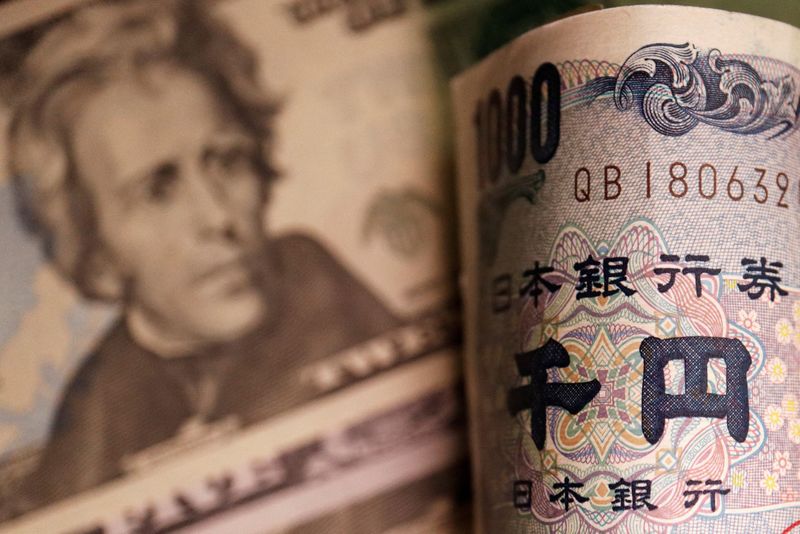
By Karen Brettell
NEW YORK (Reuters) – The yen gained on Thursday, following a sudden rally late on Wednesday that traders and analysts attributed to intervention by Japanese authorities, while the dollar was broadly lower before key jobs data on Friday.
The sharp move in the yen on Wednesday came in a quiet period for markets after Wall Street had closed, and hours after the U.S. Federal Reserve had wrapped up its policy meeting.
Fed Chair Jerome Powell confirmed the central bank’s expectation to cut rates, but acknowledged such a move would come later than expected due to stubbornly high inflation.
The dollar eased, however, due to the Fed not adopting a more hawkish tone that included the potential for further rate hikes.
The timing of the intervention was “pragmatic,” as “volumes were light, liquidity was thin, and it’s easier to make an impact at that time,” said Brad Bechtel, global head of FX at Jefferies in New York.
The dollar was last down 0.9% at 153.09 yen..
Japan’s vice finance minister for international affairs, Masato Kanda, who oversees currency policy at the Ministry of Finance, told Reuters he had no comment on whether Japan had intervened in the market.
Wednesday’s volatility came after a similar move on Monday, which was also during a time of light trading.
“Clearly they want to make as much as an impact and do it as efficiently as possible,” said Bechtel.
The Bank of Japan’s official data indicated Japan may have spent 3.66 trillion yen ($23.59 billion) on Wednesday and 5.5 trillion yen ($35.06 billion) supporting the currency on Monday to pull it back from new 34-year lows.
remove ads
.
While the supposed interventions may buy Japan some time, the trend is likely to remain negative for the Japanese currency until the U.S. economy slows and as long as the Bank of Japan disappoints traders on how far it is willing to raise rates.
The dollar remains up more than 10% against the yen this year, as traders push back expectations on the timing of a first Fed rate cut, while the BOJ has signaled it will go slow with further policy tightening after raising rates in March for the first time since 2007.
The next major U.S. economic focus that could drive further moves in dollar/yen will be Friday’s jobs report for April, which is expected to show that employers added 243,000 jobs during the month.
“A lot hinges on tomorrow’s jobs report,” said Marc Chandler, chief market strategist at Bannockburn Global Forex in New York.
A weaker number would give Japanese authorities relief, and likely pull Treasury yields and the dollar lower. A strong report, however, could send yields and the greenback higher and increase the risk of further interventions.
If 10-year Treasury yields approach the 5% region, “I’d say the dollar/yen is going to come under more pressure,” said Chandler. “It’s all about what happens with U.S. rates – we’re sort of the big moving piece.”
Benchmark 10-year Treasury yields were last at 4.57%.
Data on Thursday showed that the number of Americans filing new claims for unemployment benefits held steady at a low level last week.
remove ads
.
The fell 0.38% to 105.31, while the euro gained 0.17% to $1.0728.
The dollar weakened 0.59% to 0.91 Swiss francs after Swiss annual inflation in April accelerated faster than expected.
In cryptocurrencies, bitcoin gained 3.56% to $59,319.
Forex
Asia FX on guard before payrolls data, yen rebounds amid likely intervention
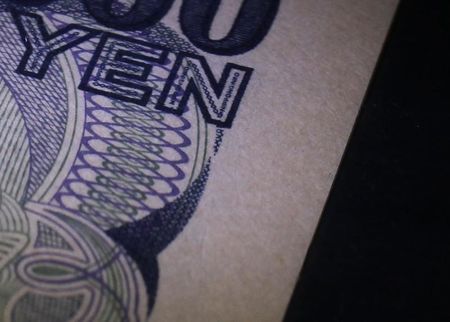
Investing.com– Most Asian currencies rose slightly on Friday, capitalizing on a drop in the dollar as markets hunkered down before key U.S. payrolls data that is likely to factor into interest rates.
The dollar was also pressured by a rebound in the Japanese yen, which pulled further away from 34-year lows amid what appeared to be government intervention in currency markets.
Weakness in the dollar offered some breathing room to regional currencies, although they were still nursing steep losses on the prospect of U.S. interest rates remaining high for longer.
Japanese yen firms amid likely intervention, USDJPY at 3-week low
The Japanese yen saw extended gains on Friday, with the pair- which moves inversely to strength in the yen- falling 0.4% to 153.02. The pair briefly hit a three-week low of 152.9.
The USDJPY pair was set to lose about 3.4% this week as it tumbled from 34-year highs. Traders and analysts attributed the drop largely to currency market intervention by the Japanese government.
The USDJPY pair had surged to 160 earlier this week. Traders said this level was the new line in the sand for currency market intervention.
Domestic Japanese markets were closed on Friday. But the lower volumes also aided the yen.
Still, the factors that had spurred recent yen weakness remained in play, chiefly the prospect of high-for-longer U.S. interest rates.
Broader Asian currencies rose slightly, capitalizing on an overnight drop in the dollar. The Australian dollar’s pair rose 0.2%, as markets positioned for potentially hawkish signals from the next week. Hotter-than-expected Australian inflation readings saw markets largely price out expectations of any rate cuts by the RBA in 2024, offering the Aussie some strength.
remove ads
.
Trading volumes in Asia remained muted on account of market holidays in Japan and China.
The South Korean won’s pair fell 0.3%, while the Singapore dollar’s pair fell 0.1%.
The Indian rupee’s pair fell slightly, and was trading well below record highs hit in April.
Dollar steadies from overnight losses, nonfarm payrolls awaited
The and steadied in Asian trade after tumbling in overnight trade, as pressure from the yen and expectations of no more interest rate hikes by the Federal Reserve dented the greenback.
Focus was now squarely on data for April, which is due later in the day. The reading has consistently beaten estimates for the past five months, with any signs of persistent labor market strength giving the Fed more headroom to keep rates high for longer.
The Fed signaled earlier this week that it had no plans to cut rates in the near-term, especially in the face of sticky inflation.
Forex
Japanese yen rises, USDJPY hits 3-week low on suspected intervention
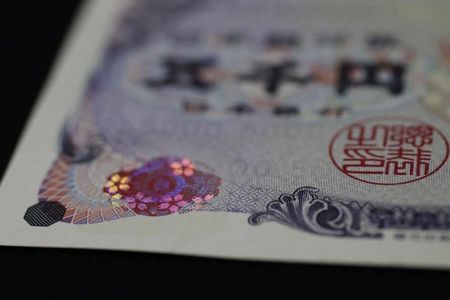
Investing.com– The Japanese yen firmed on Friday, with the USDJPY pair hitting a three-week low after sharp declines through this week that traders largely attributed to government intervention.
The pair, which gauges the amount of yen required to buy one dollar, was trading down 0.2% at 153.34 yen. It had fallen as low as 152.9 on Thursday, reaching its weakest level since mid-April.
The USDJPY pair fell sharply through this week amid increasing evidence that the Japanese government had intervened in markets on at least three separate instances- on Monday, Wednesday and Thursday.
The suspected intervention came after the USDJPY pair surged to 160 at the beginning of the week, which traders said was the new line in the sand for the yen. The Japanese currency started the week at its weakest level since 1990.
The factors that had pressured the yen in the lead-up to this week still remained in play. Recent comments from the U.S. Federal Reserve reinforced expectations that interest rates will remain high for longer.
A widening gap between U.S. and Japanese rates was a key point of pressure on the yen, with a historic rate hike by the Bank of Japan in March doing little to alleviate this pressure.
The BOJ also offered middling signals on future rate hikes during a late-April meeting, which triggered the yen’s recent bout of losses.
While Japanese government officials did not directly confirm this week’s intervention, Reuters estimated that Japan may have spent between 3.66 trillion yen and 5.5 trillion yen ($23.59 billion- $35.06 billion) when intervening in markets on Monday, based on BOJ data.
remove ads
.

 Forex2 years ago
Forex2 years agoForex Today: the dollar is gaining strength amid gloomy sentiment at the start of the Fed’s week

 Forex2 years ago
Forex2 years agoHow is the Australian dollar doing today?

 Forex1 year ago
Forex1 year agoUnbiased review of Pocket Option broker

 Forex2 years ago
Forex2 years agoDollar to pound sterling exchange rate today: Pound plummeted to its lowest since 1985

 Cryptocurrency2 years ago
Cryptocurrency2 years agoWhat happened in the crypto market – current events today

 World2 years ago
World2 years agoWhy are modern video games an art form?

 Stock Markets2 years ago
Stock Markets2 years agoMorgan Stanley: bear market rally to continue

 Economy2 years ago
Economy2 years agoCrude oil tankers double in price due to EU anti-Russian sanctions





